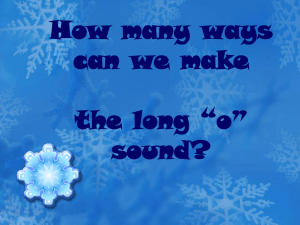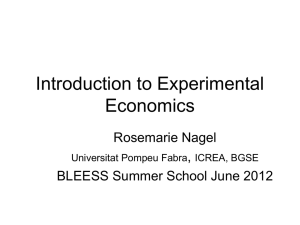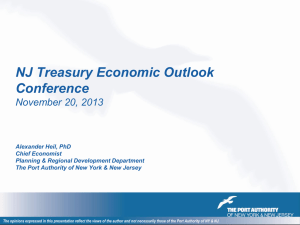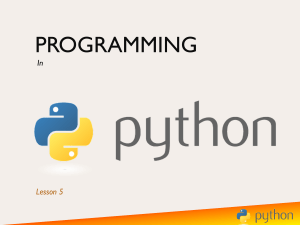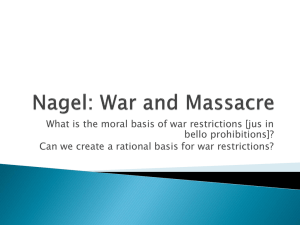Introduction
advertisement
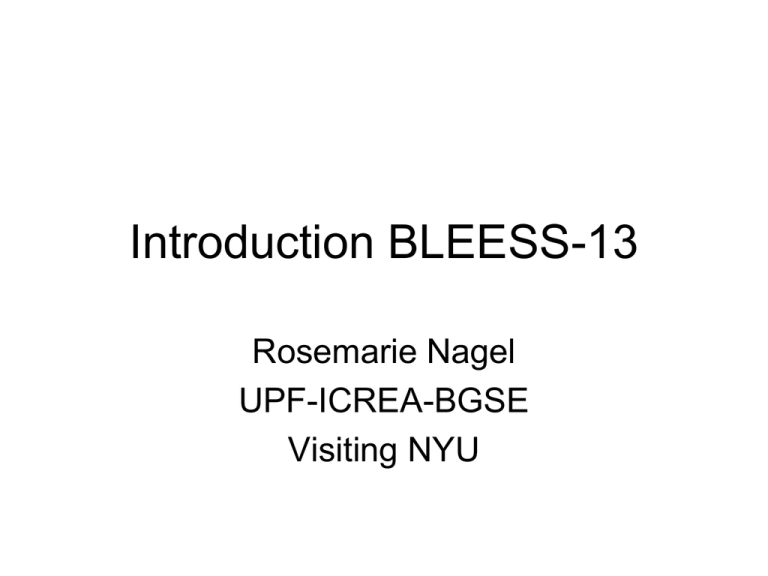
Introduction BLEESS-13 Rosemarie Nagel UPF-ICREA-BGSE Visiting NYU Our Aims • Macro research questions visited via – Theory – Experimental methods. • Why experiments and not empirical data? • Closeness to theory • Empirical data for research question not available • Spread the word that macro experiments are possible Konfuzius (孔夫子 ) 551 b. C.- 479 b. C. • "By three methods we may learn wisdom: First, by reflection, which is noblest; Second, by imitation, which is easiest; and third by experience, which is the bitterest.” • "Tell me, and I will forget. Show me, and I may remember. Involve me, and I will understand." Theodore Bergstrom and John H. Miller “Taking a course in experimental economics is a little like going to dinner at a cannibal's house. Sometimes you will be the diner, sometimes you will be part of the dinner, sometimes both” Quote from “Experiments with Economic Principles” Four step model to write/work on a research question (adapted from “On Teaching syntactic Argumentation by D.M. Perlmutter, MIT) • Step 1 : Find some interesting facts (which facts are interesting will depend of course on the current theory, state of the art etc.) • Step 2: Construct hypothesis and alternative hypothesis to account for the facts • Step 3: find grounds on which to choose between the two hypotheses: – Theoretic model construction – Experimental design – Empirical data • Step 4: get results: – Theoretic solution – (experimental/empirical) data – Tests etc. , new theories In red: what you typically learn in an economic class Sources for experimental economics • Books and surveys (experimental economics-behavioral surveys): – – – – – – – • Other sources – – – – – • Collection of experimental facts: Davis&Holt (1992), Kagel & Roth (1995) Experimental methods: Friedman & Sunder (1994), Facts and models: Camerer (2003), Behavioral economics: Camerer & Loewenstein (2005); Field experiments: Harrison and List (JEL, 2005) Neuro economics: Camerer, Loewenstein, and Prelec (JEL, 2005) Soon to come: Kagel & Roth second volume! (see already Al Roth homepage) Classroom experiments and webgames: Charles Holt (2006) Web experiments: Rubinstein, Plott etc. Field experiments: List’s webpage with papers Critics about experimental economics: Al Roth Working papers: Charles Holt Micro text books with experimental economics – – Schotter (1996) Bergstrom and Miller (1997) Game theory, Macro Applied game theory (espec. Field IO), Micro In general: Data Utility maximization Auction Equivalence Industrial Organization Competitive equilibrium Asset Markets Phenomena of stock market in lab Economic questions Psychologica l questions Individual Decision making Expected utility vs non-expected utility Behavioral economics Lab as test bed for new market design: e.g: FCC-auctions Field experiments: Bargaining Fairness vs strategic Auctions of sports cards, Newspaper experiments External validity Happiness Psychology based Neuro economics: Descriptive models e.g experiments with patients with lesions, use of brain scans while being subject in experiment (high and low game theory) Learning Social utility function Levels of reasoning Quantal response eq. Hyperbolic discounting Behavioral finance etc behavior Public good Free riding ??? what is missing COMPLEX GAMES Coordination Multiplicity Macro experiments Experimental economics: topic The Beauty Contest: Rational Expectations and Keynesian Level of Reasoning (and a tour through experimental economics) Rosemarie Nagel ICREA-UPF-BGSE Barcelona, Spain Visiting NYU Rules Choose a number between 0 and 100. The winner is the person whose number is closest to 2/3 times the average of all chosen numbers NY FED data Dec. 2012 micro seminar 0.3 relative frequencies 0.25 0.2 0.15 Mean 10.25 2/3 Mean 6.83 Winner Jason Bram: with 2* PI [= 6.2831853] (comment: This may complicate calculating an average ... but I'll take 2 x PI ) 0.1 0.05 0 choices Outline (this talk is also a tour through experimental economics using the BCG) • Lab experiment to show regularities, construct models of behavior • Field experiment to show parallelism between field and lab data • fMRI experiment (brain) to inform about behavior • Survey to induce policy implication through guesses and guesses of guesses • Macro theory: generalization of BCG through shocks and signal extraction General rule • Choose a number between 0 and 100. The winner is the person whose number is closest to 2/3 times the average of all chosen number. He gets 10 Euros. If there is tie, the pie is split amongst those who tie. (Tournament rule) • Alternative payment rule: Profit (i) =100-(choice (i) – 2/3 average)^2 Where does this game come from? Objective: Minimize distance between own number x(i) and 2/3 average <=> x(i)=2/3 average ) Lab Experiments Systematic variation of parameters to find pattern of behavior in relation with theory Surveys: Camerer 2002, Crawford, Costa Gomes, Iriberrim, JEL 2012 Basic Beauty Contest Games Varying Parameters The rules of the basic beauty-contest game: • N participants (individuals vs teams/experienced vs inexperienced) are asked to guess a number from the interval 0 to 100. N=2 is very different from N>2 • The winner is the person whose guess is closest to (2/3 times the mean of the all choices) plus constant • The winner gets a fixed/variable prize of $20. In case of a tie the prize is split amongst those who tie. • The same game may be repeated several periods • Subjects are (not) informed of the mean, 2/3 mean and all choices in each period/get a signal about current choices • Time to think: from seconds up to two weeks • Participants: students, theorists, “newspaper readers” etc text in bold italics indicates the variations in the different experiments Rules, theory, and data for basic game Classification of choices Rules Choose a number between 0 and 100. The winner is the person whose number is closest to 2/3 times the average of all chosen numbers 0 14 22 33 0 14 22 33 1. iterated elimination of dominated strategies ITERATION Equilibrium ... 0 ... E(4) E(3) E(2) 13.17 19.75 29.63 2. iterated best response ... ... E(3) E(2) E(1) 0 14.89 22.22 33 33.33 14 22 E(1) 44.44 E(0) 66.66 100 E(0) 50 100 Nagel, AER 1995 Keynes’ Beauty Contest Game Or, to change the metaphor slightly, professional investment may be likened to those newspaper competitions in which the competitors have to pick out the six prettiest faces from a hundred photographs, the prize being awarded to the competitor whose choice most nearly corresponds to the average preferences of the competitors as a whole; so that each competitor has to pick not those faces which he himself finds prettiest, but those which he thinks likeliest to catch the fancy of the other competitors, all of whom are looking at the problem from the same point of view. It is not a case of choosing those which, to the best Level 0 of one’s judgment, are really the prettiest, nor even those Level 1 which average opinion genuinely thinks the prettiest. We have reached the third degree where we devote our Level 2 intelligences to anticipating what average opinion expects the average opinion to be. And there are some, I believe, And higher who practise the fourth, fifth and higher degrees. Keynes (1936, p. 156) Period 2 behavior One dot is a subject Period 1 behavior Period 3 behavior Period 2 behavior Period 4 behavior Period 3 behavior Nagel, AER 1995 Mean behavior over time some variations 100 mean 80 4/3-mean 60 0.7-mean, 3 players 40 20 0 1 2 3 4 5 6 7 8 9 10 time Nagel 1995, Camerer, Ho AER 1998) 2/3-mean, 15-18 players 1/2-median Conclusion 1 A. Descriptive model interpretation a la Keynes • Level 0: no understanding of the game (=no • game form recognition=random play=zero intelligence) Level 1: game form recognition, but do not have a model of other players’ behavior (no theory of mind), thus assume random play = as if playing against nature, non changing past • Level 2: model others as level 1 players => have model of other players’ behavior (theory of mind) • Level 3: model others as level 2 players etc. (theory of mind) • Equilibrium: assume common knowledge of rationality or assume that others go through an infinite level of reasoning and thus assume all are equally smart (rational expectation) (theory of mind??? or just calculation mode) Conclusion 1 (cont.) • Typically level of reasoning remains between random and level 3 even over time. • Unraveling towards the rational expectation equilibrium but never reaching it (this is probably only true when zero is the equilibrium) • The level k model has been used in many other games like auctions, matching pennies *see survey by Crawford, Costa Gomes, Iriberri JEL 2012 Conclusion 1 (cont.) Modeling behavior • Level k (Stahl-Wilson, 1994, Nagel 1995) • Cognitive hierarchy (Camerer-Ho 1998) • QRE with heterogeneous errors (Breitmoser, 2012) • (in future, modeling behavior (after learning has occurred through shocks and signal extraction?) Field Experiments Parallelism between lab and field? Bosch, Montalvo, Nagel, Satorra, AER 2002 Bosch et al AER 2002 C=level 3 (15) B=level 2 (22) A=level 1 (33) Like NY-FED data Mixture models fMRI Experiments How can the brain inform us about behavior? Coricelli, Nagel (PNAS 2009) Example of MRI scanner Scanner a very powerful electro-magnet field strength of 3 teslas (T), ~60,000 times greater than the Earth’s field During the experiment: subject lies in the scanner and is exposed to the stimuli scanner tracks the signal throughout the brain Nature of fMRI activation When a brain area is more active it consumes more oxygen Changes in blood flow and blood oxygenation in the brain are indirect measures of neural activity (Blood Oxygenation Level Dependent (BOLD) signal) Neural activity increasing Blood oxygen increasing fMRI signal increasing • Data is usually transformed into “activation” maps • Activation maps show which parts of the brain are involved in a particular mental process Experimental design Conditions Guessing game (session 1) 10 participants in each “session” (2 groups) Human Computer Random Target number = 2/3 *(mean all numbers) Target number = 2/3 *(mean all numbers) Choose a number between 0-100 Choose a number between 0-100 Choose a number between 0-100 Parameters : 0.20, 0. 33,…. 1 …1.25, 1.66, 1.75 (13 parameters) Calculation task (session 2) Calculate 2/3 * 66 Calculate 2/3 * 2/3 * 66 NO info after a period Random Choose a number between 0-100 Behavior of one subject: High level reasoner Parameter 2/3 Aim: categorization of behavior of each subject into either High or low level player === difference in brain between high and low? BEHAVIOR OF TWO PLAYERS: Low vs high level Dorsal and ventral MPFC: self-other distinction dorsal MPfC 0, 48, 24 High level of reasoning 0.4 0.2 beta 0 -0.2 human -0.4 computer -0.6 -0.8 High level: Third person perspective (dorsal MPFC) & thinking about others as “like me” (ventral MPFC) -1 high low Strategic IQ mean parameter estimates (0,48,24) 0.25 0.20 0.15 0.10 0.05 0.00 -0.05 0 500 1000 1500 2000 -0.10 -0.15 -0.20 distance to the winning number Increasing strategic IQ The activy in the MPfC is correlated (r = 0.67, P = 0.005) with our measure of Strategic IQ (the inverse of the distance to the winning number). Conclusion 3 Theory of Mind • Guessing, estimating, predicting is a key feature of human activity • Desintangling low vs high reasoning: – Through fMRI we find level (0), 1 vs level 2 and higher – (as Keynes also has argued.. Not favorite face and not average face VS – Through behavior we found level 0 vs level 1 and higher • Application in psychology, neuro science, • Difference to animals? Survey Experiments Using guess and guess of guesses to make policy changes Gender composition in ESA 2011-2012 (ESA is the Association of Experimental Economics) DATA: There were 95 positions (keynote speakers, committee members etc) in 2011/2012 related to ESA positions of which 4 are occupied by women (4.2%) In particular there was one woman in ESA committee out of 19 members In 2012 there are about 27% (149/555) women members in ESA Survey by H Llavador, M Nagel, R Nagel A Perdomo How to induce change 1. Survey method – Create awareness through guesses (90% participants of survey were not aware of gender gap!) – Create cognitive dissonance between own guess guess of other people guesses and actual facts – Ask participants for different reasons for the actual gender composition – Ask participants for proposals how to change gender composition. – Ask participants for women eligible for EC 2. Document of results send to EC with actual proposals and other results of survey Four different guessing games plus incentives 1. Guess how many women are in ESA – EC – No incentives – Number can be found on web 2. Guess the guess of others about women in ESA – EC – Right guess: 100 Euros 3. How long will it take to make a change without this survey – No incentives 4. Make a proposal how to change the composition – If your proposal is implemented within next 2 years, 400 Euros (note: NO democracy, or guess of most chosen proposal, instead best guess/prediction/adapted proposal.. The real beauty contest, as e.g. in procurement auction • The prizes are given separately to men and women • Additional prize: one randomly chosen man and woman receives 100 Euros for participation Result of new election within Committee 2012 • While there was one women in 2011 in the committee, there are 4 women in 2012 in committee. • However, in 2011 the women with most votes lost by one or two votes against the elected men. • Now in 2012 the women elected won by one or two votes against the loosing men with most votes => More campaigning is necessary Conclusion 4 Usefulness for surveys • Guessing, estimating, predicting is a key feature of human activity • We can create cognitive dissonance about the state of nature/status quo and the guess/ guesses of guesses of subjects • The guesses might indicate how the ideal state should be or not be • Proposals for changes by participants => Policy change Generalized Macro Beauty Contest Model Long term aim: Macro foundation of Micro Some new modeling on BCG • BASIC GAME Where c is • A known constant (experiment Gueth, Kocher, Sutter 2002) • A common fundamental value (theory Morris Shin 2002), private and public signals about fundamental value • An ideosyncratic error with signal extraction (theory Benhabib, Wang, Wen 2012): experimental results in preparation Conclusion 4 Macro experiments • The guessing game/beauty contest game is embeded in many macro models (think of inflation expectation) • Adding shocks and signal extraction, macro context (sentiments, animal spirits) offers maybe a macro fundation of micro • Some might just be semantics like in micro we talk of errors (typically endogenous) while macro talks of shocks (typically exogenous) Conclusion We showed the relationship between rational expectation and Keynesian level of reasoning with experiments in the lab, field, brain, survey and new theorizing through macro, bridging the gap between zero intelligence and equilibrium behavior. “Experiments without Theory is useless, Theory without Experiments is dangerous” adapted from Confucius (551–479 BCE) : “learning without thinking is useless, thinking without learning is dangerous” Coauthors on the Beauty contest game (in order of appearance): R Selten J Duffy A Bosch J Montalvo A Satorra B Grosskopf G Coricelli C Plott E Chou M McConnell V Crawfort M CostaGomes C Bühren B Frank H Llavador M Nagel A Perdomo J Benhabib


